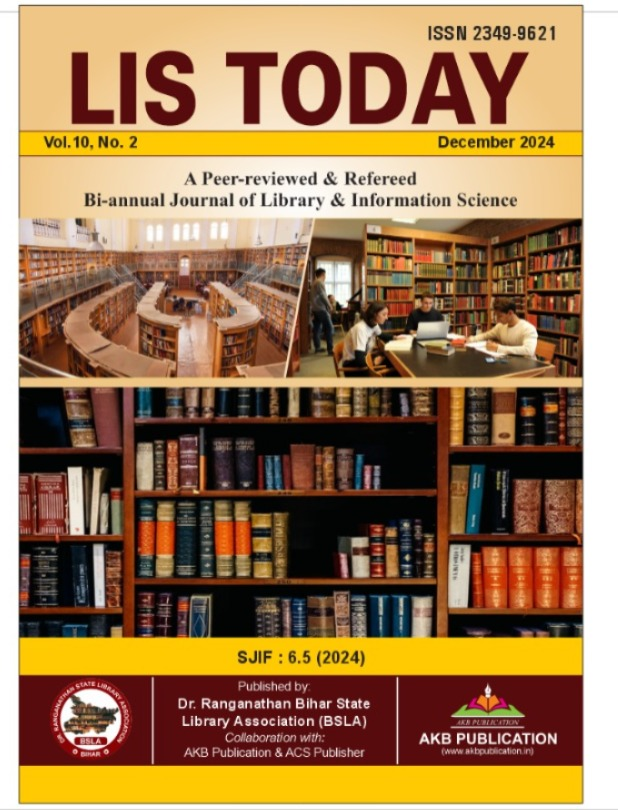BEYOND EYE’S ASSISTIVE TECHNOLOGIES AND PERSONS WITH DISABILITIES (DIVYANGJAN): GLOBAL PUBLIC LIBRARY PERSPECTIVE
Keywords:
Assistive technology (AT), Activities of daily living (ADLs or ADL), Accessible Educational Materials (AEM), Assistive Listening Device (ALD), Audio-Assisted Reading (AAR), Augmentative and Alternative Communication (AAC) System, Digital Talking Book (DTB), Do-It-Yourself (DIY), Emotional and Behavioral Disorder (EBD)Abstract
This Paper is prepared to make aware the Person with Visual impairment as well as Librarians who is serving to visually impaired community about assistive technology. It dwells upon the use and importance of assistive technologies in general and their use for visually Impaired Library users in particular. Further, it gives suggestions for implementing assistive technologies in Public libraries for making visually Impaired Library users and self-reliant learners in accomplishing their academic and research pursuits.
References
[1] Assistive technology device.(2016). U.S. Department of Education. Retrieved from http://idea.ed.gov/explore/view/p/,root,statute I,A,602,1
[2] Ault, M. J., Bausch, M. E., & McLaren, E. M. (2013). Assistive technology service delivery in rural school districts. Rural Special Education Quarterly, 32(2), 15-22. Retrieved fromhttp://search.proquest.com/docview/1420524203?accountid=50681
[3] Baker, E. A. (2005). Personal digital assistants: Effects on performance and perceptions of students with special needs (pp. 1-69).
[4] Boen, R. D. (2014). Evaluation of general and specific assistive technology knowledge among students with disabilities in postsecondary environments (1568444). Available from ProQuest Dissertations & Theses Full Text: The
[5] Humanities and Social Sciences Collection. (1609717978). Retrieved from http://search.proquest.com/docview/1609717978?accountid=50681
[6] Candido, J. P. (2009). Visual impairment in a visual medium: perspectives of online learners with visual impairments (AAI3338731). Available in PsycINFO. (622065180; 2009-99090-394). Retrieved from http://search.proquest.com/docview/622065180?accountid=50681
[7] Carter, K. L. (2013). What is the impact of the use of assistive technology (AT) on the attitudes about students with significant disabilities of general education teachers and nondisabled peers?(1524181). Available from ProQuest Dissertations & Theses Full Text: The Humanities and Social Sciences Collection. (1449382407). Retrieved from http://search.proquest.com/docview/1449382407?accountid=50681
[8] Chmiliar, L., & Anton, C. (2015).The iPad as a mobile assistive technology device. Journal of Assistive Technologies, 9(3), 127. Retrieved from http://search.proquest.com/docview/1718489931?accountid=50681 [9] Chmiliar, L., & Cheung, B. (2007). Assistive technology training for teachers: Innovation and accessibility online. Developmental Disabilities Bulletin, 35(1-2), 18-28. Retrieved from http://search.proquest.com/docview/622023582?accountid=50681
[10] Coleman, M. B., Cramer, E. S., Park, Y., & Bell, S. M. (2015). Art educators’ use of adaptations, assistive technology, and special education supports for students with physical, visual, severe and multiple disabilities. Journal of Developmental and Physical Disabilities, doi:http://dx.doi.org/10.1007/s10882-015-9440-6 148. [11] Freedom Scientific. (2014). Retrieved from http://www.freedomscientific.com Friend, C. (2009). Meeting the needs of the visually impaired persons: what challenges for IP. In a meeting hosted by WIPO in Geneva. Retrieved from http://www.wipo.int/meetings/en/2009/vip_ge/presentations/chris_friend.html [12] Graves, P. R. (2015). Assistive technology use among americanindian/alaskan natives with mild disabilities (AAI3671685). Available from PsycINFO. (1746990154; 2015- 99211-358). Retrieved from http://search.proquest.com/docview/1746990154?accountid=50681
[13] Hung, H. (2008). Teachers' perspectives about braille literacy in Taiwan (AAI3292766). Available from PsycINFO.(621735136; 2008-99110-153).http://search.proquest.com/docview/621735136?accountid=50681 [14] Hussin, A. (2014). Experiences of students with visual impairments in adoption of digital talking textbooks: An interpretative phenomenological analysis
(AAI3593393). Available from PsycINFO.(1547268905; 2014-99131-053). Retrieved from http://search.proquest.com/docview/1547268905?accountid=50681
[15] Hemann Judy (2014) Retrieved on March 2015
https://www2.ed.gov/about/offices/list/ocr/letters/colleague-bullying-201410.pdf [16] Jernigan, K (1986)A Definition of Blindness Retrieved April 10,2015 from
https://nfb.org/images/nfb/publications/fr/fr19/fr05si03.htm
[17] Kamei-Hannan, C., Howe, J., Herrera, R. R., & Erin, J. N. (2012). Perceptions of teachers of students with visual impairments regarding assistive technology: A follow-up study to a university course. Journal of Visual Impairment & Blindness, 106(10), 666-678. Retrieved from
http://search.proquest.com/docview/1442399658?accountid=50681
[18] Kelly, S. M. (2009). Use of assistive technology by students with visual impairments: Findings from a national survey. Journal of Visual Impairment & Blindness, 103(8), 470-480. Retrieved from http://search.proquest.com/docview/851233618?accountid=50681
[19] Kelly, S. M., & Smith, T. J. (2008). The digital social interactions of students with visual impairments: Findings from two national surveys. Journal of Visual Impairment &Blindness,102(9), 528-539. Retrieved from http://search.proquest.com/docview/222023120?accountid=50681

